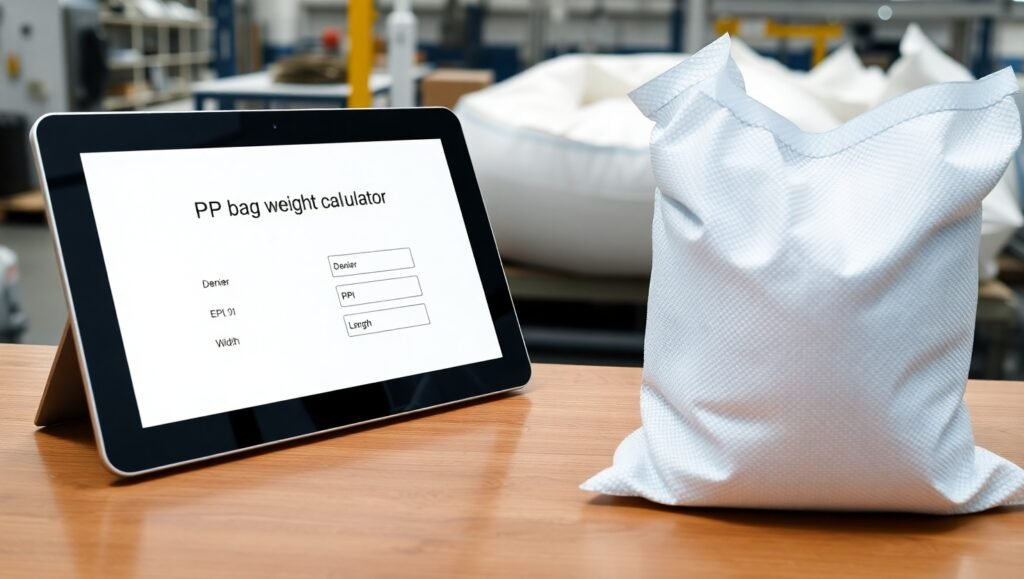PP Woven Bag Weight Calculator (from Denier)
How to Use the PP Woven Bag Weight Calculator
This tool calculates the estimated weight of a polypropylene (PP) woven bag based on its size and material specifications. Follow these simple steps:
Step 1: Select Your Measurement Unit
- Use the dropdown menu to choose whether your bag measurements are in Inches or Centimeters.
Step 2: Enter the Bag Dimensions
- In the “Bag Length” field, enter the height of the finished bag.
- In the “Bag Width” field, enter the width of the finished bag.
Step 3: Enter the Material Specifications
- Denier: Enter the thickness of the PP tape used to weave the fabric (e.g., 700, 900, 1200). A higher number indicates a thicker, stronger tape.
- Ends Per Inch (EPI): This is the number of warp threads (lengthwise threads) per inch. A typical value is often between 10 and 14.
- Picks Per Inch (PPI): This is the number of weft threads (widthwise threads) per inch. This value is usually the same as or very close to the EPI.
Step 4: Calculate the Result
- Click the green “Calculate Bag Weight” button.
Step 5: Review the Results
The tool will display a box with three key pieces of information:
- Bag Area: The total surface area of your bag in square meters (m²).
- GSM: The Grams per Square Meter of the woven fabric based on your inputs.
- Estimated Bag Weight: The final result—the total weight of the empty bag in grams.
Example:
To calculate the weight of a common 50kg bag:
- Unit: Inches
- Length: 30 inches
- Width: 18 inches
- Denier: 900
- EPI: 10
- PPI: 10
- Result: The estimated bag weight would be approximately 95.3 grams.

Frequently Asked Questions: PP Woven Bag Weight Calculator from Denier
1. What is denier, and why is it important?
Denier is a unit of measurement for the linear mass density of fibers. It represents the weight in grams of 9,000 meters of the thread. A higher denier number (e.g., 1200) indicates a thicker, stronger, and heavier polypropylene tape, which directly contributes to a bag’s durability and weight.
2. What is the difference between EPI and PPI?
- EPI (Ends Per Inch): Also known as warp density, this counts the number of threads running vertically (the length of the fabric) in one inch.
- PPI (Picks Per Inch): Also known as weft density, this counts the number of threads running horizontally (the width of the fabric) in one inch.
Together, they determine the fabric’s weave tightness and overall density.
3. My bag has a gusset. Why isn’t the weight accurate?
This calculator is designed for simple flat bags (e.g., T-shirt bags, simple sacks). A gusset is an extra panel that adds significant additional material. To calculate the weight of a gusseted bag, you need to account for the extra area of the gusset itself, which this current version does not include.
4. The result is in grams. How do I convert it to pounds or ounces?
You can easily convert the result:
- To Ounces: Divide the gram result by 28.35.
- To Pounds: Divide the gram result by 453.6.
5. What is a typical GSM range for PP woven bags?
GSM (Grams per Square Meter) can vary widely based on use:
- Light-duty bags (e.g., for retail): 40 – 70 GSM
- Standard duty bags (e.g., for grain, fertilizer): 70 – 100 GSM
- Heavy-duty bags (e.g., for construction sand, chemicals): 100+ GSM
6. Can I use this calculator for materials other than Polypropylene (PP)?
The formula is specifically designed for PP woven fabrics. Other materials, like polyester or nylon, have different densities and properties, so the calculated weight would not be accurate. The tool is best used specifically for polypropylene bags.
7. Where can I find the denier, EPI, and PPI for my bag?
This information should be provided by your bag manufacturer or supplier in the product specifications sheet. If not, they can typically measure it for you upon request.
More useful tools: 1) Number to Words Converter, 2) PP Woven Bag Weight Calculator (from Denier), 3) PP Woven Bag Denier Estimator